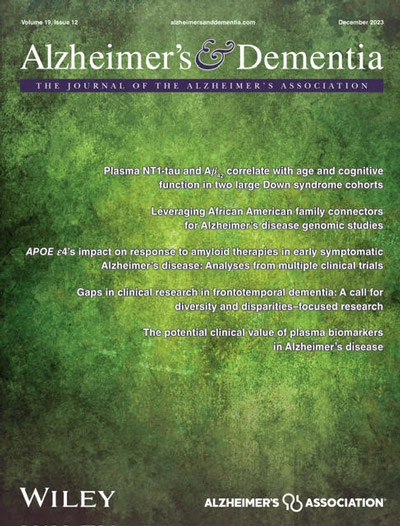摘要
引言 在磁共振成像(MRI)技术中,跨血脑屏障(BBB)的水交换率(Kw)被用来评估 BBB 的功能。阿尔茨海默病(AD)患者 BBB Kw 的变化仍不确定。 方法 该研究包括 38 名认知正常且无阿尔茨海默病生物标志物的个体(CN_A-)、30 名认知正常的个体(CN_A+)和 31 名认知受损且有阳性阿尔茨海默病生物标志物的个体(CI_A+)。参与者接受了临床评估、核磁共振成像/正电子发射断层扫描和血浆生物标志物检测。 结果 在整个注意力缺失症连续过程中的多个大脑区域观察到 Kw 显著降低。Kw的变化与血浆生物标志物和神经心理学表现相关。磷酸化 tau 217 水平的升高加剧了 Kw 与神经心理学表现之间的反比关系。Kw、脑容量和血浆生物标志物的整合显示了区分注意力缺失症连续阶段的潜力。 讨论 在注意力缺失症的整个过程中,Kw的持续降低是显而易见的,可作为早期注意力缺失症筛查的诊断工具。 亮点 观察发现,在阿尔茨海默病(AD)的连续阶段,多个脑区的水交换率(Kw)都在下降,尤其是海马、海马旁回和脑深部核团。 不同脑区的Kw水平与血浆生物标志物以及AD连续体的神经心理学表现之间存在着很强的相关性。 海马区血浆磷酸化tau(p-tau)217和Kw之间的相互作用与执行功能有关,这表明血脑屏障Kw和p-tau 217对认知能力产生了共同的不利影响。 结合使用Kw、脑容量和血浆生物标志物--神经丝蛋白轻链和胶质纤维酸性蛋白--显示了区分AD连续体中个体的潜力。

INTRODUCTION
Water exchange rate (Kw) across the blood–brain barrier (BBB) is used in magnetic resonance imaging (MRI) techniques to evaluate BBB functionality. Variations in BBB Kw across the Alzheimer's disease (AD) continuum remain uncertain.
METHODS
The study encompassed 38 cognitively normal individuals without AD biomarkers (CN_A–), 30 cognitively normal (CN_A+), and 31 cognitively impaired individuals (CI_A+) with positive AD biomarkers. Participants underwent clinical assessments, MRI/positron emission tomography scans, and assays of plasma biomarkers.
RESULTS
Significantly lower Kw was observed in multiple brain regions throughout the AD continuum. This alteration in Kw correlated with plasma biomarkers and neuropsychological performance. Elevated levels of phosphorylated tau 217 intensified the inverse relationship between Kw and neuropsychological performance. The integration of Kw, brain volume, and plasma biomarkers demonstrated potential in distinguishing stages within the AD continuum.
DISCUSSION
Consistently lower Kw was evident across the AD continuum and may act as a diagnostic tool for early AD screening.
Highlights
- Observations revealed a decline in water exchange rate (Kw) across multiple brain regions within the Alzheimer's disease (AD) continuum, notably in the hippocampus, parahippocampal gyrus, and deep brain nuclei during the preclinical stage of AD.
- Strong correlations were established between Kw levels in various brain regions and plasma biomarkers, as well as neuropsychological performance in the AD continuum.
- Interaction between plasma phosphorylated tau (p-tau)217 and Kw in the hippocampus was linked to executive function, indicating a combined detrimental impact on cognitive abilities stemming from both blood—brain barrier Kw and p-tau 217.
- The combined use of Kw, brain volume, and plasma biomarkers—neurofilament light chain and glial fibrillary acidic protein—demonstrated potential for distinguishing individuals within the AD continuum.

 求助内容:
求助内容: 应助结果提醒方式:
应助结果提醒方式:


